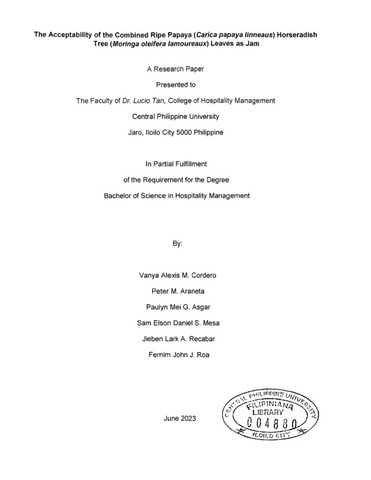| dc.contributor.adviser | Hisuan Jr., Armando | |
| dc.contributor.author | Cordero, Vanya Alexis M. | |
| dc.contributor.author | Araneta, Peter M. | |
| dc.contributor.author | Asgar, Paulyn Mei G. | |
| dc.contributor.author | Mesa, Sam Elson Daniel S. | |
| dc.contributor.author | Recabar, Jieben Lark A. | |
| dc.contributor.author | Roa, Fernim John J. | |
| dc.date.accessioned | 2023-10-18T07:03:01Z | |
| dc.date.available | 2023-10-18T07:03:01Z | |
| dc.date.issued | 2023-06 | |
| dc.identifier.citation | Cordero, V. A. M. , Araneta, P. M. , Asgar, P. M. G. , Mesa, S. E. D. S. , Recabar, J. L. A. & Roa, F. J. J. (2023). The acceptability of the combined ripe Papaya (Carica papaya Linnaeus) Horseradish tree (Moringa oleifera Lamoureaux) leaves as jam [Unpublished special paper]. Central Philippine University. | en_US |
| dc.identifier.uri | https://hdl.handle.net/20.500.12852/2840 | |
| dc.description | Special paper abstract | en_US |
| dc.description.abstract | To have a healthier alternative to the common jam that is sold in markets, the researchers decided to conduct a study on papaya and horseradish tree as jam. Regarding accessibility, the study's raw ingredients are easily accessible all year round in the city's wet markets. The descriptive approach was applied in this descriptive study because descriptive research focuses on acquiring data to describe and interpret current circumstances or conditions. One hundred respondents in one of the Private Higher Education Institutions were chosen to participate in this study and rate the level of Acceptability of the Combined Ripe Papaya and Horseradish Tree Leaves as Jam in terms of appearance, aroma, and taste. The respondents' ages ranged from 18 to 59, and were randomly selected using an accidental sampling method. The researchers created a research survey instrument and corrections were taken into account when creating the questionnaire's final draft. The researchers secured permission from the Dean to administer a questionnaire to respondents on the First Semester of the Academic Year 2022-2023. The results were retrieved, scored and statistically treated using statistical tools. Data showed no significant differences in all three sensory characteristics, appearance, aroma, and taste, according to respondents' classifications, age, and sex. The study found that most respondents were students, ages 25 and below, and female. The average acceptability level of respondents on the confined Ripe Papaya and Horseradish Tree leaves as jam according to their sensory characteristics, which included appearance, aroma, and taste was highly accepted.
Keywords: Papaya, Horseradish Tree, Jam, Appearance, Aroma, Taste, Acceptability, Classification, Significance, Descriptive, Sex and Age. | en_US |
| dc.format.extent | x, 118 leaves | en_US |
| dc.language.iso | en | en_US |
| dc.subject.lcc | TX 911 .C673 2023 | en_US |
| dc.subject.lcsh | Cooking (Horse-radish) | en_US |
| dc.subject.lcsh | Cooking (Papaya) | en_US |
| dc.subject.lcsh | Food--Odor | en_US |
| dc.subject.lcsh | Food--Sensory evaluation | en_US |
| dc.subject.lcsh | Ingredient substitutions (Cooking) | en_US |
| dc.title | The acceptability of the combined Ripe Papaya (Carica papaya linneaus) Horseradish Tree (moringa oleifera lamoureaux) leaves as jam | en_US |
| dc.type | Special paper | en_US |
| dcterms.accessRights | Not publicly accessible | en_US |
| dc.description.bibliographicalreferences | Includes bibliographical references | en_US |
| dc.contributor.chair | LUCEÑO, MYRNA | |
| dc.contributor.committeemember | Chu, Fuman C. | |
| dc.contributor.committeemember | Almajar, Ismael A. Jr. | |
| dc.contributor.department | College of Hospitality Management | en_US |
| dc.description.degree | Bachelor of Science in Hospitality Management | en_US |
| local.subject | Carica papaya linneaus | en_US |
| local.subject | Moringa oleifera lamoureaux | en_US |
| local.subject.scientificname | Carica papaya | en_US |
| local.subject.scientificname | Moringa oleifera | en_US |


